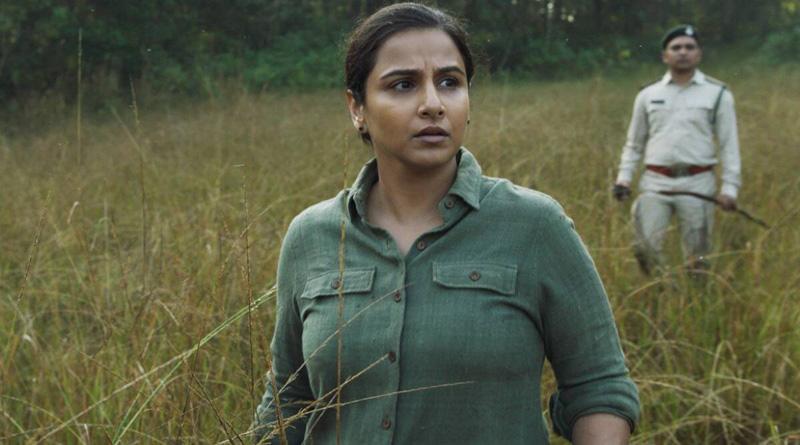 Image
Image
For Vidya Balan-starrer Sherni the makers used academic rigour to study the topic of conservation
Recently-released Sherni featuring Vidya Balan as an IFS (Indian Forest Service officer) has been lauded for its realistic and empathetic portrayal of the forest and its surrounding communities as well as for bringing the topic of wildlife and conflict into a mainstream film. Mongabay-India writer Srikant Chaudhary spoke to Shernis director Amit Masurkar and writer Aastha Tiku on the choice of the subject, the characters and the films attempt at portraying reality
About eight percent of the total recorded species of flora and fauna of the world and four of the world’s 34 biodiversity hotspots are located in India, according to Global Forest Watch. About a quarter of the total geographical area of the country is forested. In these forests, are stories of people, animals and their interactions – a recent Hindi film tells one such story. The film Sherni (tigress, in Hindi), released on the online streaming platform Amazon Prime, has captured the complexities and challenges of life in the forest where humans and wildlife strive to coexist. The story focuses on a woman IFS (Indian Forest Service) officer, played by popular female actor Vidya Balan who navigates the workings of the forest department.
EXCERPTS:
We don’t see many films made in India on critical aspects of forest conservation and tribal communities. But in your last two films you chose these very topics, what was your thought process in selecting stories revolving around these issues?
Amit Masurkar: I choose these topics because I care about them. I know that there’s a large audience that would connect with these stories. Cinema is a very powerful medium and can help shape popular culture and society.
The conflict between human and wildlife is one of the most critical issues of our time. What motivated you to weave a story around it?
Aastha Tiku: Climate change and conservation are pressing issues that need visibility and are essential for the survival of the human species. But they are also intimidating topics and very broad topics to discuss. Therefore, I felt the need to tell a human story that will appeal and relate to all and generate curiosity and awareness towards this topic.
Making films like Newton and Sherni is probably not easy in a mainstream star-dominated industry, how do you manage to make such relatable and honest stories on topics like democracy, tribal rights, and environmental conservation? Is there any role of evolving media like OTT (over-the-top media service)?
Amit Masurkar: The tough part is the writing. I’ve had no issues finding actors or producers for Newton or Sherni. New age actors and producers are looking for stories that are socially relevant and different from the rest.
The plot resembles the story of the tigress Avni from Maharashtra, why did you write the story around a real incident, how did you research the same?
Aastha Tiku: If you talk about human-animal conflict, the same cluster of issues exist in tandem with each other not just within India but also in other countries that still have their wildlife intact. The story was interwoven after detailed research on multiple case studies and bears no resemblance to any one particular case.
.jpg)
Sherni on location. Director Amit Masurkar with writer Aastha Tiku. Photo courtesy Amazon Prime.
The protagonist of Sherni is a woman. She is also as vulnerable in the male-dominated forest department, as the tigress is on human-dominated land. How did you write the character of the female IFS officer, Vidya Vincent?
Aastha Tiku: As a female writer I naturally gravitate towards writing about female protagonists. It was important for me to create a character that has a unique lens of looking at the world. Gender is a subplot in the film and it was a deliberate decision to do so as I strongly felt that in a story like this just talking about gender alone would not do anything for the story. The focus always was conservation and understanding the topic of human-animal conflict in detail.
The characters, including the small ones, are diverse and relatable, how did you come up with such details and what was your research like, especially on the functioning of the forest department?
Aastha Tiku: I always say that for any work of fiction, a lot of effort must be put into carrying out in-depth research. It was a combination of primary research (ethnographic immersions), and secondary research (desk research and reading works of post-colonial theorists). For Sherni we used academic rigour to study the topic of conservation and therefore it is rich and populated with nuance in both world-building and character exploration.
Sherni is one of the few mainstream Hindi films authentically portraying a community living around a forest and caught in human-animal conflict. Are the people who play members of the community, professional actors or are they from the community and have faced human-animal conflict in their daily lives? How did you achieve such a realistic performance?
Amit Masurkar: Apart from Sampa Mandal who plays Jyoti, who’s a National School of Drama alumna, the rest of the village residents were playing themselves. They live in and around the same villages where we shot their scenes. We did acting workshops with those who responded to our casting call and then selected actors. All of them knew the story, the scene and their parts well in advance.
.jpg)
“As a female writer I naturally gravitate towards writing about female protagonists,” says Sherni writer Aastha Tiku. Photo courtesy Amazon Prime.
Interestingly these are locations where human-animal conflict takes place. Did you feel the intensity of the problem while filming? What were the challenges of filming in such locations?
Amit Masurkar: Bhootpalasi and Jondra are the villages where we shot the village and fields. They border the jungle but luckily the people there have learnt to coexist. They see an occasional leopard but they take precautions to stay safe. We never felt unsafe while shooting.
The minimalist treatment of the jungle, animals, and conflict scenes are the most sensible, why is such an authentic portrayal important in films like Sherni which subtly talks about larger issues of conservation and environment?
Amit Masurkar: That’s the only way this story could be told! What is shown is happening all around us. Habitats are shrinking. Species are getting extinct. Climate change is real. Without an authentic and sincere portrayal, a film on such a topic is difficult to pull off.
Sherni is quite unlike typical jungle films, when writing the script were you confident of getting such a realistic story made in a mainstream Bollywood setup?
Aastha Tiku: A writer must have a well-formed worldview about the story they want to tell. They should have clarity and command over the pulse of the story. The intent was not to titillate the audience or create unnecessary drama or use tropes to keep them engaged. It is a world that needed a more rooted treatment. It was important to not succumb to the pressures of ‘entertaining’ audiences. An honest piece of work, in my opinion, holds its ground very well.
Top Headlines
-
Environment
Indi Setu: Wildlife on the Brink: Can We Rewild a Warming World?
October 25, 2025
-
Environment
SonaSPEED motors power NASAISRO synthetic aperture radar mission
August 01, 2025
-
Environment
How green is my city
July 01, 2025
-
Environment
India's River Dolphin: Clear And Present Danger
May 28, 2025
-
Environment
South Kashmir The costs of coexisting with predatory wildlife
May 12, 2025
-
Environment
Sariska Tiger Reserve: A maharani recognised
May 02, 2025
-
Environment
Arunachal Pradesh: Retracing a century-old biodiversity in Siang Valley
April 04, 2025
-
Environment
Toxic air and smog choke Delhi as experts at COP29 in Baku warn how dragging feet on fossil fuel reduction can cause catastrophe
November 19, 2024
-
Environment
The last feral horses of India
November 11, 2024
-
Environment
Indian savannas: New remote sensing study spotlights misclassification and flawed tree-planting
September 16, 2024

